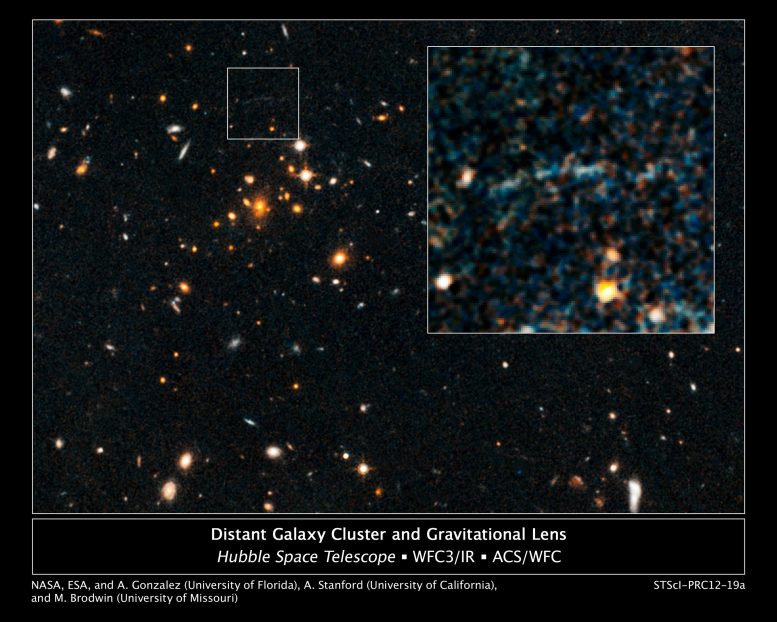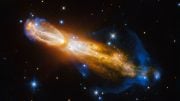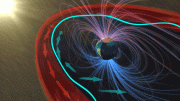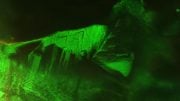
These images, taken by NASA’s Hubble Space Telescope, show an arc of blue light behind an extremely massive cluster of galaxies residing 10 billion light-years away. Credit: NASA/ESA/University of Florida, Gainsville/University of Missouri-Kansas City/UC Davis
Astronomers have discovered an arc of light behind a galaxy cluster that is 5 to 10 times larger than other clusters from that early of a time in the universe’s history and weighs as much as 500 trillion suns, leaving astronomers with many questions.
Seeing is believing, except when you don’t believe what you see.
Astronomers using NASA’s Hubble Space Telescope have found a puzzling arc of light behind an extremely massive cluster of galaxies residing 10 billion light-years away. The galactic grouping, discovered by NASA’s Spitzer Space Telescope, was observed when the universe was roughly a quarter of its current age of 13.7 billion years. The giant arc is the stretched shape of a more distant galaxy whose light is distorted by the monster cluster’s powerful gravity, an effect called gravitational lensing.
The trouble is, the arc shouldn’t exist.
“When I first saw it, I kept staring at it, thinking it would go away,” said study leader Anthony Gonzalez of the University of Florida in Gainesville. “According to a statistical analysis, arcs should be extremely rare at that distance. At that early epoch, the expectation is that there are not enough galaxies behind the cluster bright enough to be seen, even if they were ‘lensed’ or distorted by the cluster. The other problem is that galaxy clusters become less massive the farther back in time you go. So it’s more difficult to find a cluster with enough mass to be a good lens for gravitationally bending the light from a distant galaxy.”
Galaxy clusters are collections of hundreds to thousands of galaxies bound together by gravity. They are the most massive structures in our universe. Astronomers frequently study galaxy clusters to look for faraway, magnified galaxies behind them that would otherwise be too dim to see with telescopes. Many such gravitationally lensed galaxies have been found behind galaxy clusters closer to Earth.
The surprise in this Hubble observation is spotting a galaxy lensed by an extremely distant cluster. Dubbed IDCS J1426.5+3508, the cluster is the most massive found at that epoch, weighing as much as 500 trillion suns. It is 5 to 10 times larger than other clusters found at such an early time in the universe’s history. The team spotted the cluster in a search using NASA’s Spitzer Space Telescope in combination with archival optical images taken as part of the National Optical Astronomy Observatory’s Deep Wide Field Survey at the Kitt Peak National Observatory, Tucson, Arizona. The combined images allowed them to see the cluster as a grouping of very red galaxies, indicating they are far away.
This unique system constitutes the most distant cluster known to “host” a giant gravitationally lensed arc. Finding this ancient gravitational arc may yield insight into how, during the first moments after the Big Bang, conditions were set up for the growth of hefty clusters in the early universe.
The arc was spotted in optical images of the cluster taken in 2010 by Hubble’s Advanced Camera for Surveys. The infrared capabilities of Hubble’s Wide Field Camera 3 (WFC3) helped provide a precise distance, confirming it to be one of the farthest clusters yet discovered.
Once the astronomers determined the cluster’s distance, they used Hubble, the Combined Array for Research in Millimeter-wave Astronomy (CARMA) radio telescope, and NASA’s Chandra X-ray Observatory to independently show that the galactic grouping is extremely massive.
CARMA helped the astronomers determine the cluster’s mass by measuring how primordial light from the Big Bang was affected as it passed through the extremely hot, tenuous gas that permeates the grouping. The astronomers then used the WFC3 observations to map the cluster’s mass by calculating how much cluster mass was needed to produce the gravitational arc. Chandra data, which revealed the cluster’s brightness in X-rays, was also used to measure the cluster’s mass.
“The chance of finding such a gigantic cluster so early in the universe was less than one percent in the small area we surveyed,” said team member Mark Brodwin of the University of Missouri-Kansas City. “It shares an evolutionary path with some of the most massive clusters we see today, including the Coma Cluster and the recently discovered El Gordo Cluster.”
An analysis of the arc revealed that the lensed object is a star-forming galaxy that existed 10 billion to 13 billion years ago. The team hopes to use Hubble again to obtain a more accurate distance to the lensed galaxy.
Gonzalez has considered several possible explanations for the arc.
One explanation is that distant galaxy clusters, unlike nearby clusters, have denser concentrations of galaxies at their cores, making them better magnifying glasses. However, even if the distant cores were denser, the added bulk still should not provide enough gravitational muscle to produce the giant arc seen in Gonzalez’s observations, according to a statistical analysis.
Another possibility is that the initial microscopic fluctuations in matter made right after the Big Bang were different from those predicted by standard cosmological simulations, and therefore produced more massive clusters than expected.
“I’m not yet convinced by any of these explanations,” Gonzalez said. “After all, we have found only one example. We really need to study more extremely massive galaxy clusters that existed between 8 billion and 10 billion years ago to see how many more gravitationally lensed objects we can find.”
The team’s results are described in three papers, which will appear in the July 10, 2012 issue of The Astrophysical Journal. Gonzalez is the first author on one of the papers; Brodwin, on another; and Adam Stanford of the University of California at Davis, on the third.
References:
“IDCS J1426.5+3508: Sunyaev–Zel’dovich Measurement of a Massive Infrared-Selected Cluster at Z = 1.75” by M. Brodwin, A. H. Gonzalez, S. A. Stanford, T. Plagge, D. P. Marrone, J. E. Carlstrom, A. Dey, P. R. Eisenhardt, C. Fedeli, D. Gettings, B. T. Jannuzi, M. Joy, E. M. Leitch, C. Mancone, G. F. Snyder, D. Stern and G. Zeimann, 26 June 2012, The Astrophysical Journal.
DOI: 10.1088/0004-637X/753/2/162
“IDCS J1426.5+3508: Cosmological Implications of a Massive, Strong Lensing Cluster at Z = 1.75” by Anthony H. Gonzalez, S. Adam Stanford, Mark Brodwin, Cosimo Fedeli, Arjun Dey, Peter R. M. Eisenhardt, Conor Mancone, Daniel Stern and Greg Zeimann, 26 June 2012, The Astrophysical Journal.
DOI: 10.1088/0004-637X/753/2/163
“IDCS J1426.5+3508: Discovery of a Massive, Infrared-Selected Galaxy Cluster at Z = 1.75” by S. A. Stanford, M. Brodwin, Anthony H. Gonzalez, Greg Zeimann, Daniel Stern, Arjun Dey, P. R. Eisenhardt, Gregory F. Snyder and C. Mancone, 26 June 2012, The Astrophysical Journal.
DOI: 10.1088/0004-637X/753/2/164








Maybe what “Hubble Spots Extremely Rare Gravitational Arc” Hubble is looking at is another Massive Galaxy (Like Andronama or the Milky Way) on ther other side of the Universe or perhaps what were seeing is the fracture in time and space/Beginning of our part of the universe, This idea would stretch the mind to believe the Universe was created not by one (1) big bang, but perhaps several could be proof of the theory of two membranes coliding creating these fractures or Gravatational Arcs.
Just a thought:
Maybe what (Hubble Spots Extremely Rare Gravitational Arc) Hubble is looking at is another massive galaxy (Like Andronama or the Milky Way) on ther other side of the Universe or perhaps what were seeing is the fracture in time and space/Beginning of our part of the universe. This idea would stretch the mind to believe the Universe was created not by one (1) big bang. Perhaps several of these fractures “Gravational Arcs”, could be proof of the theory about two membranes colliding together. Creating these fractures or Gravatational Arcs. Just Saying……
KGG